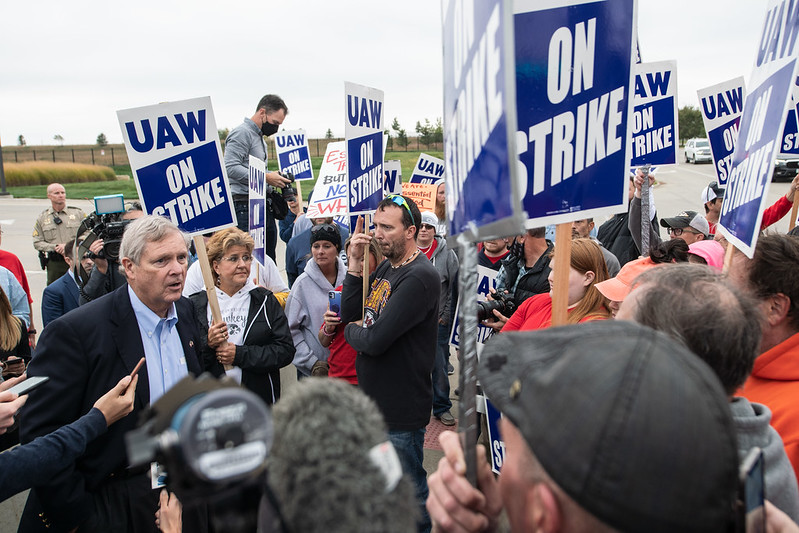
U.S. Department of Agriculture USDA Secretary Tom Vilsack met with the men and women of United Auto Workers Local 450 as they continue their fight for a fair wage, better benefits, and a secure retirement at the John Deere Des Moines Works, in Ankeny, Iowa, on October 20, 2021. USDA Photo by Lance Cheung.
A High Stakes Gamble
Negotiations with United Auto Workers and automakers have been ongoing since mid-July. The current contract, covering roughly 150,000 workers, ended 14 September. A prolonged strike against one or all three companies is expected to significantly thump the supply chain and the economy, warns Forbes magazine.
The transition to electric vehicles (EVs), which labor activists fear may come at the cost of union jobs, is fueling the strike. Tesla is the chief competitor to the Detroit automakers in the government-mandated electric vehicle race. The medium worker at Tesla earned $34,084 last year in total compensation, compared to $80,034 at GM, according to the WSJ.
Yet labor is one of the few variables auto makers can control, which is why Tesla and foreign auto makers have tried to avoid unionization by expanding in U.S. right-to-work states. Mr. Fain is vindicating their decision.
What UAW Wants
- 40 hours of pay for a 32-hour workweek.
- a 46% pay raise.
- defined-benefit pensions (rather than 401(k)s for all workers.
- cost of living adjustments.
The United Auto Workers union is at an impasse with automakers because of the federal government’s centrally planned “transition” to electric vehicles, charges NRO Editors.
Electric vehicles are much less complicated than ordinary cars. Fewer workers are needed to produce them. In other contexts, fewer workers producing the same number of products is a good thing. But that’s only the case when it’s a product consumers actually want.
The shift to EVs is being driven by government, not by the market. As Democrats have used legislation and the administrative state to push electric vehicles far faster than the technology permits, the UAW has kept the donations flowing, and progressives have cheered.
Under Shawn Fain, UAW’s president since March, the union has a long list of demands, including a bigger share of the automakers’ profits. The Big Three automakers worry that Fain’s demands will make them less competitive against non-union car makers, like Tesla.
Fain is looking for a 36% pay increase over four years, a 32-hour workweek with overtime for additional hours, the restoration of retiree health benefits, and defined-benefit pensions (rather than 401(k)s) for all workers, as well as cost-of-living adjustments.
In many ways, this strike is made in Washington, accuses the WSJ, due to the Biden administration’s policy of mandating a rapid transition to electric vehicles.
The UAW knows that EVs require fewer workers to make and will jeopardize union jobs making gas-powered cars. But the companies already lose money on EVs and worry about making too many concessions to the UAW that will cause them to lose even more as they are forced to build more EVs.
Unintended Consequences
Will Mr. Fian look like a hero when less competitive companies disappear? Who will be the losers when jobs vanish? Fingers will point to the misguided industrial policies from the man occupying the White House.
If a strike happens, automakers will no longer need parts, creating a ripple effect. Supplies will be forced to make tough decisions on how to wind down operations and take out costs, warns Forbes.
More important, how will businesses ramp back up after the strike ends to meet the demand?
If you’re willing to fight for Main Street America, click here to sign up for the Richardcyoung.com free weekly email.





